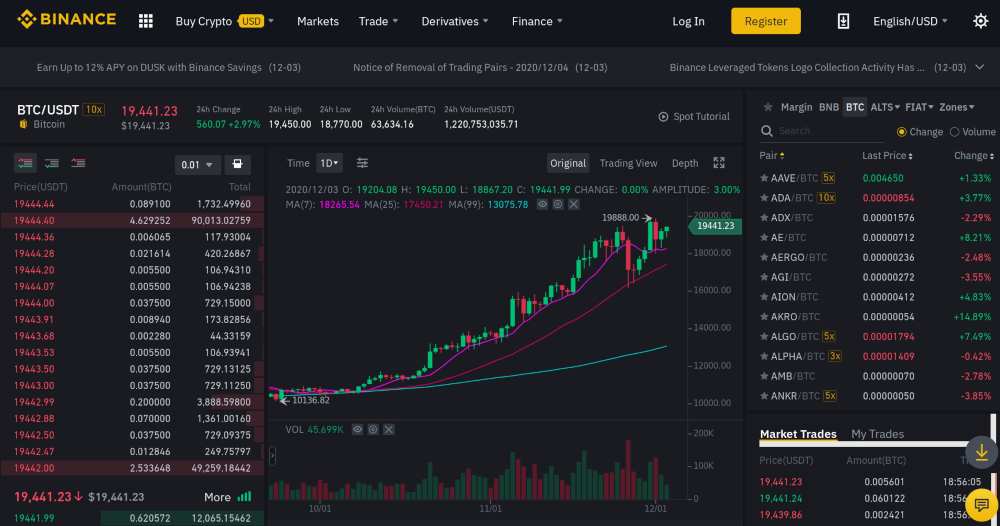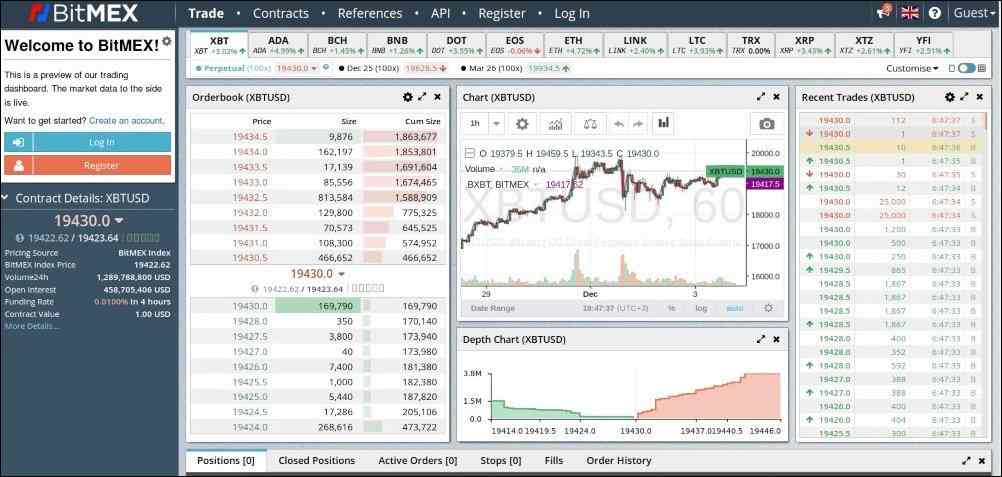The Top 4 Exchanges for Margin Trading in 2022 - Ultimate Guide


In contrast to the crypto boom of 2017, this time the cryptocurrency market is less wild. There are many corporate investors, there are venture investors, and ex-stock traders who joined cryptocurrency trading/investing. Many famous professionals were vocal about the positive role of cryptocurrencies and big companies are working on blockchain-based solutions. Moreover, it is speculated that the extraordinary BTC price growth of late 2017 was not driven by the natural market process but rather was forced by the manipulations of certain cryptocurrency companies. Although we are yet to learn the truth about the last bull run, we can see that now the Bitcoin price has hit a new all-time-high gradually and it keeps on fluctuating, shaking the altcoins market. These price moves create a strong opportunity to earn profits out of buying and selling cryptocurrencies. How do we maximize this profit? One of the popular ways is using margin trading. In this article, we will talk about how margin trading works and what exchanges provide the best modern margin trading services.
Margin Trading 101
Margin trading exists for a long time and was used before the invention of cryptocurrencies. We are not going to highlight its history or compare traditional margin trading to margin trading in the cryptocurrency sphere. We will focus solely on the way it works on modern crypto exchanges.
Trading is a kind of short-time investment. It's understood that the more you invest, the more gains you may reach. But how can you quickly earn much on trading if you have only $100 that you can afford to invest? One of the most obvious answers is through margin trading.
The concept of margin trading is easy to grasp: traders borrow money from the crypto exchange they trade on using their own money as collateral. In a good situation, trading with a bigger amount brings them a bigger profit. When the trade is over, the user brings the borrowed money and back to the exchange. The interest rate is deducted, too. The rest of the profit goes to the trader.
For instance, you believe that the price of Bitcoin is going to move from $19,000 to $20,000 very soon. You provide 100 USDT as collateral, choose the 100:1 leverage (usually called 100x) and receive a 9,900 USDT margin from the exchange. This money goes to your margin account, separate from the rest of your money held on the exchange. Let's say, your prediction is 100% right, you buy around 0.526 BTC at 19 thousand USDT and then sell 0.526 BTC at 20 thousand USDT receiving 10,526.31 USDT. If you have invested only $100, you would make only 5.26 USDT out of this trade. The borrowed money goes back to the exchange, the collateral is spent, and your profit before subtracting interest rate and the trade fee is $526,31 — 100 times more than you would get investing only $100 that you actually owned in the very beginning. That's how the good scenario looks like.
There are more things to explain when it comes to bad scenarios. Exchanges won't let you lose the money they lend you. If the market trend is opposite to what you've thought, eventually you will receive a margin call from the exchange. It happens when the price hits a certain threshold that is perceived as too risky to continue the trade with the same collateral and leverage. A margin call is a message from the exchange requiring to increase the collateral. If it is impossible the position gets liquidated. If the additional collateral doesn't help, the position gets liquidated, too. That's a risk to lose the money you've invested entirely. This fact obligates traders to keep their eyes on the margin levels.
There are many ways traders can earn via margin trading. Even in the bear market, traders can get profits through short positions. Of course, it's important to understand how the market behaves and don't forget about the types of orders which helps to secure the funds from losses. It is widely considered that margin trading is for experienced traders. Anyway, paying attention to what you do when it comes to your money is always important. Now let's review some of the most convenient cryptocurrency exchanges that provide a margin trading option.
HitBTC
Wins and losses in margin trading are higher that's why it's important to rely on a powerful trading engine and use the exchange with high liquidity. HitBTC is one of the first exchanges that comes to mind when speaking of margin trading.
 This exchange has been in the industry since 2013. For 7 years, HitBTC keeps its position among the top crypto exchanges despite high competition and widens its functionality. Throughout this time, HitBTC has never experienced security breaches. In terms of liquidity, HitBTC has a trading volume of roughly $900 million. The exchange supports 414 crypto coins that makeup over 900 trading pairs. It makes HitBTC one of the most diverse crypto trading platforms providing enough room for experimenting with obscure coins and trading the leading cryptocurrencies. Another sweet trait of this platform is low fees. The maximum trading fee is set at the 0.09% mark while those who trade in large amounts (which is more probable if you use the margin trading feature) can enjoy fee discounts or even get a rebate bonus for each trade.
This exchange has been in the industry since 2013. For 7 years, HitBTC keeps its position among the top crypto exchanges despite high competition and widens its functionality. Throughout this time, HitBTC has never experienced security breaches. In terms of liquidity, HitBTC has a trading volume of roughly $900 million. The exchange supports 414 crypto coins that makeup over 900 trading pairs. It makes HitBTC one of the most diverse crypto trading platforms providing enough room for experimenting with obscure coins and trading the leading cryptocurrencies. Another sweet trait of this platform is low fees. The maximum trading fee is set at the 0.09% mark while those who trade in large amounts (which is more probable if you use the margin trading feature) can enjoy fee discounts or even get a rebate bonus for each trade.
Dear Traders,
— HitBTC (@hitbtc) December 7, 2020
Margin Trading is now live on our Android & iOS Mobile Apps!
Now you can access up to 12x leverage on HitBTC on selected trading pairs from the convenience of your smartphone.
Find out more: https://t.co/XbUsx5p5gI pic.twitter.com/Hysq7mRrqZ
Since the main focus of this article is margin trading, let's see what HitBTC can offer those who are looking for leveraged trading. First and foremost, HitBTC has a clear P&L (alternatively PNL, profit and loss). When you open a position it is critically important to adequately estimate the unrealized P&L. This figure is a value between the deposit and the final payout of the open position. PNL is what you get when you close the position. Thanks to HitBTC's layout, this info can be clearly monitored at any given moment. The most important data can be seen even in the exchange browser tab! This allows users to be heads up while browsing other pages.
As for the coins available for margin trading, on HitBTC you can trade the following pairs: BTC/USDT and ETH/USDT can be traded with up to 12x leverage while 23 other pairs (based on USDT or BTC) are traded with 10x or 5x leverage. All of the supported coins are top coins traded in pairs with BTC or USDT.
The ease of use is in general one of HitBTC's nice features. For a registered trader, it takes only about a minute to start margin trading while registration itself doesn't take much time, too. To start trading with the leverage provided by the exchange, the user needs to have a confirmed email address and enable 2-factor authentication (actually, enabling this feature is a must for any trader as it seriously enhances the security level of the account). What makes margin trading on HitBTC even more convenient is the fact that this function is featured in the exchange's mobile app. Not many big exchanges provide the margin trading feature in their mobile apps, yet. A great feature is the Demo Mode. You can practice margin trading without investing real money. As you will get your experience on how to trade with the leverage in the sandbox, you will be able to try earning crypto coins on the main platform.
In September 2021, HitBTC added another feature allowing traders to use leverage. The feature is perpetual futures trading. Positions with these futures do not expire with time while collateral assets can be removed or added by the trader to alter the asset of the position. The maximum leverage available for trading perpetual futures is 75x. The assets supported for this feature are BTC, ETH, TRX, BCH, ADA, DOT, SOL, EOS, AAVE, MATIC, XLM, UNI, LTC, and HIT.
Binance
Binance is a well-established exchange founded in 2017. Nowadays, the exchange has the largest liquidity in the industry. The trading volume exceeds $6 billion while the rest exchanges struggle to reach $2 billion in volume. However, even much smaller liquidity can be enough to perform fast trading. You just can be sure that on Binance, you have the smallest chance of stuck orders. Apart from huge trading volume, Binance is known for a huge number of supported coins (although this number is much smaller than on HitBTC) — 260 cryptocurrencies in 880+ trading pairs. Binance is a crypto-to-crypto platform, so it is important to purchase crypto coins elsewhere before start trading there. Alternatively, users can buy cryptocurrencies via the OTC trading desk on Binance. As for security, the platform is trusted despite the fact that it was hacked in 2019 with 7,000 BTC stolen. The company CEO stated that the users' assets are not affected or will be compensated.
 As for December 2020, Binance provides an opportunity to borrow money in over 40 cryptocurrencies. The maximum leverage available on Binance is only 5x — not as much as on other trading platforms. As for pros, on Binance margin trading feature is available for the mobile app users. It's not a mainstream thing yet, although we already saw that HitBTC provides margin trading in its app, too.
As for December 2020, Binance provides an opportunity to borrow money in over 40 cryptocurrencies. The maximum leverage available on Binance is only 5x — not as much as on other trading platforms. As for pros, on Binance margin trading feature is available for the mobile app users. It's not a mainstream thing yet, although we already saw that HitBTC provides margin trading in its app, too.
Margin Trading Enabled on #Binance for:
— Binance (@binance) November 30, 2020
🔸 @ArdorPlatform $ARDR
🔸 @hard_protocol $HARD
🔸 @LTOnetwork $LTO
🔸 @zilliqa $ZILhttps://t.co/at3khDfVvF
It's obligatory for Binance users to complete KYC and enable 2-factor authentication before they can open a margin account. In the margin, account traders use a regular interface with a couple of extra features — a risk monitor section and the Borrow Assets button. To create collateral, the trader must move her/his money to a margin wallet. The money transfers between the user's wallets are free of charge. In a margin wallet, the user can choose the amount of collateral and specify the leverage amount. If the position is liquidated, the user not only loses her/his money but also pays the extra fees. So it's important to keep track of the risk monitor and take action when the risk level is going up. Another feature of the margin account is the switcher. It is used to borrow more money in one click switching a regular order mode to a margin order with borrowed money. When the trade is over, the leveraged funds should be repaid manually.
BitMEX
BitMEX is another long-withstanding platform in the crypto trading universe. It was founded in 2014 and is still mentioned in many lists of the best platforms for margin trading although the exchange is not that popular among beginners in crypto trading. The reason is clear: Bitmex has a more complex structure than many modern exchanges. Unlike most popular platforms, on BitMEX people trade derivatives instead of coins. Additionally, users can trade futures and perpetual contracts on BitMEX. This very concept may seem too tangled for fresh crypto traders and alienate them. Nevertheless, BitMEX is a pioneer in cryptocurrency margin trading. This feature became available on this exchange back in 2015. Still, BitMEX holds its position as a competitive exchange platform and is actively used by traders globally.

This platform is registered in Seychelles and has offices in the US and Hong Kong. BitMEX is a p2p platform. The exchange supports over 10 currencies which is not a big amount and can disappoint some traders looking for certain coins. However, the selection includes many popular currencies including USDT, Bitcoin, Ethereum, Litecoin, XRP, Cardano, EOS, Tron, Binance Coin, Bitcoin Cash, Ethereum Classic, Dash, Zcash, Monero, and so on. Bitcoin is a base currency on BitMEX. Fiat money can't be withdrawn and deposited. The nice feature is that BitMEX doesn't charge fees for withdrawals and deposits. Maker trading fees are well below 0.1% while taker fees are quite high — 0.25% for all currencies, except Bitcoin. The BTC taker trading fee is only 0.07%. The exchange is considered to be secure and private.
Margin trading is one of the main features of BitMEX. For Bitcoin contracts, traders can have up to 100x leverage. Ethereum contracts can be boosted with 50x leverage. The maximum leverage for Monero is 25x. So it is important to check the conditions before choosing the coin as the opportunities available for different currencies can be extremely unequal. Traders must be able to cover the total margin maintenance amount because the leverage is provided by the other users of BitMEX (we have mentioned that the platform is p2p). That's the reason why the trader's balance cannot fall below zero.
Overall, it's fair to say that BitMEX is good enough for experienced traders who want to trade Bitcoin with huge leverage and have enough money to cover possible losses if they occur. The platform is not suited for traders who have little funds.









WhatsApp him on +84 94 767 1524.
Or Email Jeffsilbert 39 @ gmail. Com